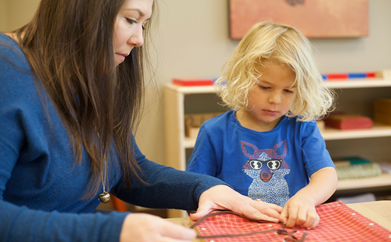Material Highlight: Dressing Frames
So much of what we do in Montessori environments are with the goal of the child’s independence in mind. Children may need our support sometimes, but children are capable of much more than people realize.
Each of our environments has ways of implementing practical life skills and practice activities that are developmentally appropriate and engaging for the children that will use them. While children of all ages benefit from practical life work, it tends to be the most obvious and discussed in the primary classroom (Children’s House). This is because, between the ages of three and six, children are achieving physical autonomy for the first time in their lives. Their days revolve around finding ways to be physically independent of the adults in their lives.
What could be more empowering (and useful) to the young child than being able to dress themselves?
To practice the refined skills of getting dressed, we have The Dressing Frames. This series of materials was created so that the child can practice a wide variety of closure methods that they will encounter on all different types of clothing.
The Dressing Frames are stored on a narrow, wooden stand. This stand was developed to store and display twelve separate wooden frames in a way that is accessible to the children without taking up excessive floor space in the classroom. This four-sided tower has enough space for three frames on each side.
Each Dressing Frame is made of wood with fabric attached to create a surface. On each frame, two separate pieces of fabric meet in the center with various types of fasteners for the child to learn about and use. These include:
● Small buttons
● Large buttons
● Bow tying
● Lacing
● Hook and eye
● Safety pins
● Snapping
● Zipping
● Buckling
● Side-release buckling
● Shoe lacing
● Hook and loop (Velcro)
When the child first begins using these materials, the Guide will give a lesson just as they would with other academic materials. Montessori lessons are very methodical and deliberate, and they include repeated modeling each step of processes.
The Guide begins by inviting the child to join them for a lesson. The pair walks over to the wooden stand, and the Guide tells the child what the material is called and selects the first (small button) frame. They will sit at a table with the frame in front of them. After letting the student know what the lesson will be about, the two continue in silence. The Guide demonstrates how to hold a button carefully between two fingers while pulling the fabric taught with the other hand. They slowly insert a portion of the button into the hole and demonstrate how to carefully pull it all the way through. This continues with each button as the Guide works their way down the frame, fastening each button. Each movement is slow and deliberate, breaking the task into smaller steps that the child can see.
Part of any work in a Montessori classroom is leaving the material ready for the next user, so the Guide then demonstrates how to undo each button from its hole. At this point, the child is eager to have a turn of their own, and the Guide invites the child to have a turn The Guide will remain for a moment to observe, but if the child is working without needing assistance, the adults will let the child continue. If assistance is needed, the adult is there to model again.
The child will continue to work with the small button frame periodically until they have mastered it. Depending upon the child and their individual development, this could take hours, days, weeks, or months. Whenever they are ready, the Guide will help them by giving a lesson for the next frame in the series. These steps continue until the child has had an opportunity to master all twelve frames, and therefore is prepared to fasten and unfasten a variety of their own clothing.
Being able to dress oneself is a huge step in independence. The frames may seem so simple to us as adults, but to the child, they are a key to becoming their own individual. We are fortunate to be able to aid them on that journey.





